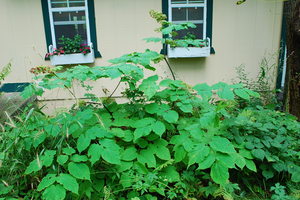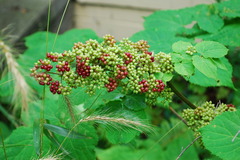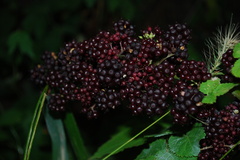Spikenard - a multi-purpose native plant

A single Spikenard (Aralia racemosa) plant spreads in my front yard
Rick Meader|Contributor
Until I worked one summer at the Nichols Arboretum, I had never heard of Spikenard (Aralia racemosa). It was a mystery plant, a plant on the specified list of plantings for the Reader Center’s entry garden. I didn’t know whether it was native or alien, big or small, or what kind of flowers it had. I searched the catalogs and inventory of local nurseries but couldn’t find it. I did see it on the internet, but still had no clue where I would find it.
And then, one day, I was talking with Greg Vaclavek of Native Plant Nursery at his booth at the Ann Arbor Farmers Market and noticed on his plant list that he had it listed as a plant native to Michigan. In a way only a true plant nerd could understand, I was elated. I had found the elusive white whale of a native. And, as I learned more about it, and planted one in my own yard, I came to realize what a great and useful plant for the landscape it is. So, without further ado, let me introduce you to my friend Spike Nard.
When people see my specimen plant in my front yard, they usually ask about it. It’s an attention-getting plant that reaches a height of about three and a half to four feet, but it’s not a shrub. It’s herbaceous and perennial, so it dies completely back in the late fall, only to sprout from its roots in late May. It has compound, alternately-arranged toothed leaves that are somewhat oval in shape. In July, it blooms with clusters of tiny yellow flowers on the end of branches that attract tiny little bees. Later, those clusters of flowers morph into clusters of little round yellow berries that slowly turn to a burgundy red. I have never actually seen anything feeding on the berries, but they always disappear, so I assume some little bird(s) have had a good meal or two, thanks to Spike.

A large cluster of Spikenard berries starting to ripen
Rick Meader|Contributor
Spikenard is native to almost all of eastern North America. I have seen it in the wild down here, and in northern Michigan. Its range extends north to Manitoba, Ontario and Quebec, south to Georgia and Texas, and southwest to Arizona. It prefers situations with shady, rich soils. In my yard, it does great in a spot with partial shade, and dry (i.e. unwatered) soils that probably wouldn’t be considered rich.
According to the website of the Robert Freckmann Herbarium of the University of Wisconsin-Stevens Point, it can be found in boreal forest and Northern and Southern Upland and Lowland Forest communities in Wisconsin, which are similar to woodland habitats in Michigan. As a member of the ginseng family, it had many uses by Native Americans.
According to the Freckmann Herbarium website, its root was used by Menominee and Potawatomi for a root beer, and as a medicine for earaches, sore throats, muscle pain and sores/bleeding.
According to the University of Michigan - Dearborn website (http://herb.umd.umich.edu - which lists 83 different entries for its use by Native Americans), some of the uses were as burn dressing and a treatment for weak backs by the Cherokee, a cough remedy by the Chippewa and a cure for tapeworm by the Iroquois. The Micmac used the root to treat spitting blood, headaches and female pains. It was a popular plant, as you can tell.

A cluster of Spikenard berries, ready to feed wildlife
Rick Meader|Contributor
For landscaping purposes, you can use it as a specimen plant, or as a tall backdrop for other plants. It can reach a height of three to four feet, and the flowers and berries all provide color in the yard in the summer and fall. Its habit is fairly open, so it is a good neighbor to other plants. Right now, in my yard, my spikenard is full of burgundy berries, so much so that the plant is bending over with the weight of them. It’s a fun, showy plant that can make a nice addition to almost any yard with shady conditions.
This week, blooming in my yard are Brown-eyed Susan, Green-headed coneflower, White snakeroot, Heart-leaved aster, Bluestem goldenrod, Canada goldenrod, and New England aster. One last blast, of goldenrods and asters, remains before it shuts down for the winter.
Enjoy nature, everyone!
Rick is a local landscape architect with a special interest in all things natural, including native plants and the critters that eat them. You can contact him at yourland1824@gmail.com.


Comments
Mike
Fri, Mar 22, 2013 : 6:30 p.m.
Rick I use this plant in all my garden designs....and by the way one client has it in her garden and it is 8 feet tall... so they can grow taller then 3 feet...just so you know..
Susan Bryan
Sun, Sep 26, 2010 : 9:27 p.m.
I have this plant in my garden too - it is a great texture plant. Nice leaves, beautiful berries. I have it along my foundation on the north side of the house and it does beautifully in the dry shade. Very useful plant!